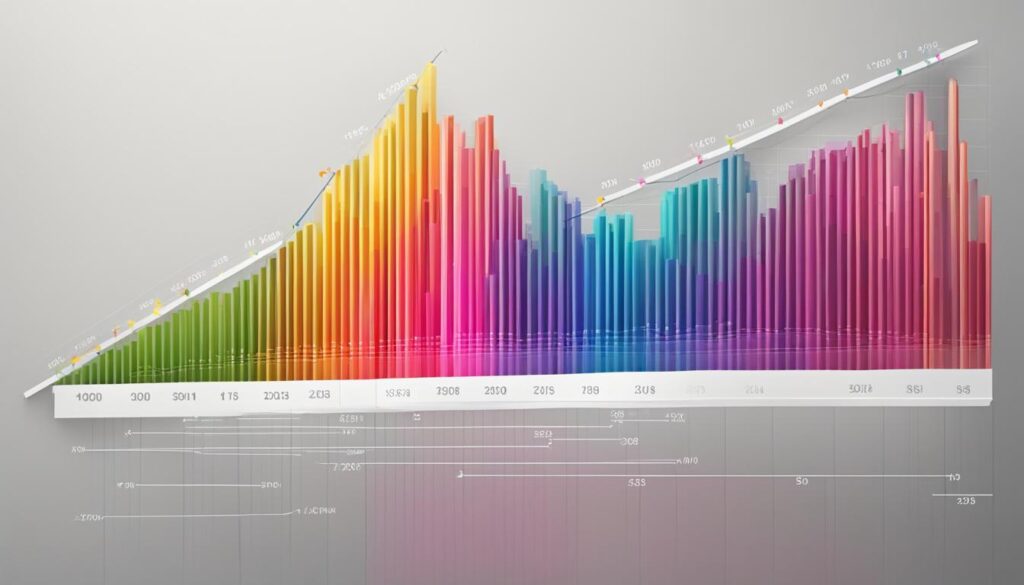Tracking your savings is a fundamental aspect of reaching your financial goals. By monitoring your progress, you can stay organized, estimate the time it will take to achieve your goals, and make necessary adjustments to your spending habits or savings rate. The act of tracking also provides motivation and keeps you focused on what truly matters in your journey to financial success.
Key Takeaways:
- Savings monitoring is crucial for achieving financial goals.
- Tracking progress helps you stay organized and estimate timelines.
- Adjusting spending habits and savings rate is easier when monitoring progress.
- Tracking savings motivates you to stay on track and focused.
- Tracking savings increases awareness of spending habits.
The Benefits of Tracking Savings
Tracking your savings offers numerous advantages that can help you stay on top of your financial goals and achieve financial success. By measuring your progress, staying organized, gaining motivation, and increasing awareness of your spending habits, you can effectively manage your finances and make informed decisions.
Measure Progress
One of the key benefits of tracking your savings is the ability to measure your progress towards your financial goals. By consistently monitoring your savings, you can see how close you are to reaching your targets. This gives you a clear picture of where you stand and allows you to make necessary adjustments to your savings strategy or spending habits.
Stay Organized
Tracking your savings also helps you stay organized. By keeping detailed records of your savings and expenses, you can easily track where your money is going and identify areas where you can cut back. This level of organization allows you to optimize your financial management and ensure that you are on track to achieving your goals.
Motivation and Awareness
In addition to measuring progress and staying organized, tracking your savings provides motivation and increases awareness of your spending habits. When you see tangible progress towards your goals, it motivates you to continue saving and stay focused. Moreover, being aware of your spending habits allows you to identify potential areas for improvement and make conscious choices that align with your financial objectives.
| Advantages of Tracking Savings | Description |
|---|---|
| Measuring Progress | Track your savings to see how close you are to reaching your financial goals. |
| Staying Organized | Keep detailed records of your savings and expenses to optimize your financial management. |
| Motivation and Awareness | Visualize your progress and gain motivation while increasing awareness of your spending habits. |
By tracking your savings, you can effectively manage your finances, make informed decisions, and work towards achieving your financial goals.
Fun Ways to Track Your Savings
Tracking your savings doesn’t have to be a boring and mundane task. In fact, there are plenty of fun and creative ways to stay motivated and organized on your journey to reaching your financial goals. Whether you prefer the convenience of technology or the simplicity of pen and paper, there’s a tracking method that suits your style.
Spreadsheets
For the tech-savvy individuals, spreadsheets can be an effective and customizable tool for tracking savings. Using platforms like Google Sheets or Microsoft Excel, you can create a personalized savings tracker that allows you to input your financial information, track your progress, and even transfer money to your savings accounts directly from the spreadsheet. With the ability to add formulas and visual progress charts, spreadsheets provide a comprehensive overview of your savings journey.
Budgeting Apps
If you prefer a more automated approach, budgeting apps can be a great option. These apps not only help you track your savings but also import your transactions automatically, making it easier to monitor your spending habits. Popular budgeting apps like Mint and YNAB allow you to set savings goals, categorize your expenses, and provide real-time updates on your progress. With the convenience of having all your financial information in one place, budgeting apps simplify the tracking process.
Worksheets, Planners, and Printables
For those who enjoy a more hands-on approach, worksheets, planners, and savings tracker printables can provide a tangible way to track your savings. These tools often come in the form of downloadable templates that you can print and fill out as you progress towards your goals. They typically include sections for setting goals, tracking deposits and withdrawals, and visual representations of your progress. By physically coloring in the milestones or crossing off completed goals, you can visually see your savings grow and stay motivated along the way.
Whether you choose spreadsheets, budgeting apps, or printable trackers, the key is to find a method that resonates with you. By making the tracking process enjoyable and engaging, you’ll be more likely to stay committed to your financial goals and achieve the financial stability you desire.

| Tracking Method | Pros | Cons |
|---|---|---|
| Spreadsheets | Customizable, comprehensive overview, progress charts | Requires manual data input, learning curve for some |
| Budgeting Apps | Automated, real-time updates, transaction imports | May have subscription fees, potential for syncing issues |
| Worksheets, Planners, and Printables | Tangible, hands-on, visual representation | Requires manual tracking, potential for loss or damage |
Setting Short-Term and Midterm Financial Goals
Setting goals is an important step in achieving financial stability. By establishing clear objectives, you can create a roadmap to guide your financial decisions and track your progress. In this section, we will explore short-term and midterm financial goals that can help you build a strong foundation for your future.
Short-Term Financial Goals
Short-term financial goals focus on immediate needs and lay the groundwork for long-term financial success. Here are a few key goals to consider:
- Create a budget: Developing a budget allows you to keep track of your income and expenses, identifying areas where you can cut back or save.
- Build an emergency fund: Setting aside funds for unexpected expenses can provide peace of mind and protect you from financial setbacks.
- Pay off debt: Prioritizing debt repayment can free up resources and improve your credit score, putting you in a better financial position.
By setting and achieving these short-term goals, you can establish a solid financial foundation and gain control over your financial situation.
Midterm Financial Goals
Midterm financial goals focus on the medium-term future and help you plan for specific milestones and larger expenses. Consider these midterm goals:
- Obtain insurance policies: Protecting yourself and your loved ones with life, health, and property insurance is a crucial step in ensuring financial security.
- Saving for specific purposes: Whether it’s saving for a child’s education or a down payment on a new car, setting aside funds for specific goals gives you a clear target to work towards.
By setting midterm goals, you can better prepare for the future and ensure that you have the resources necessary to achieve your long-term financial objectives.
Summary
Setting short-term and midterm financial goals is essential for building a strong financial foundation. By creating a budget, building an emergency fund, paying off debt, obtaining insurance, and saving for specific purposes, you can take control of your finances and achieve financial security. Remember to regularly evaluate your goals, adjust your plans if necessary, and stay focused on your objectives.

Conclusion
Tracking your savings goals and progress is a critical step towards achieving financial stability. By setting specific goals, establishing deadlines, and automating your savings, you significantly increase your chances of success. Prioritizing your goals and regularly evaluating your progress ensures that you stay on track and make necessary adjustments along the way.
Financial stability is not only about reaching your savings goals; it’s also about creating a solid foundation for your future. By automating your savings, you develop a consistent and disciplined approach to managing your money. This not only helps you achieve your goals faster but also prepares you for unexpected expenses and provides a safety net.
Remember to prioritize your goals based on their importance and urgency. While it’s essential to save for the future, don’t neglect your short-term needs and immediate financial obligations. By finding the right balance, you can enjoy both the peace of mind that comes with reaching your savings goals and the freedom to live comfortably in the present.
In conclusion, tracking your savings progress is a powerful tool that empowers you to take control of your financial future. By setting clear goals, monitoring your progress, and automating your savings, you pave the way for financial stability and long-term success. Start tracking your savings today and see how it transforms your financial journey.
FAQ
Why is tracking your savings important?
Tracking your savings helps you stay organized, estimate the time to reach your goals, make adjustments to your spending habits or savings rate, and stay motivated and focused on your financial goals.
How can tracking my savings benefit me?
Tracking your savings allows you to measure your progress, stay organized and focused, visually represent your progress, increase awareness of your spending habits, and make necessary adjustments to your plan.
What are some fun ways to track savings?
Some fun ways to track savings include using spreadsheets, budgeting apps, worksheets and planners, and savings tracker printables that can be customized and colored in.
What are short-term and midterm financial goals?
Short-term financial goals include creating a budget, building an emergency fund, and paying off credit card debt. Midterm goals involve obtaining insurance policies and saving for specific purposes like college education or a new car.
Why is setting and tracking savings goals important?
Setting and tracking savings goals is essential for achieving financial stability. By creating specific goals, setting deadlines, and automating savings, you increase the likelihood of success and prepare for unexpected expenses and retirement.
How Can Milestone Markers Help in Tracking Savings Progress?
Milestone markers play a vital role in tracking savings progress and celebrating financial success. These markers act as reminders of important goals achieved along the way. Each milestone achieved can represent a step closer to reaching financial objectives, providing motivation and a sense of accomplishment. By acknowledging and celebrating these accomplishments, individuals can stay motivated and inspired to continue their savings journey.
Pingback: Risk Ruler: Gauging Your Investment Comfort Zone – Straight Fire Money